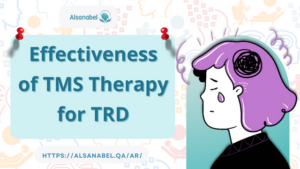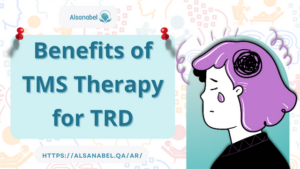Is TMS Therapy the Answer for Treatment-Resistant Depression? 2024
- Category TMS device
Transcranial Magnetic Stimulation (TMS) has emerged as a promising treatment option for individuals struggling with treatment-resistant depression. With TMS being at least twice as effective as standard treatments, it has garnered attention for its safety and efficacy. This blog post will delve into the robust evidence supporting TMS as a viable treatment strategy for those with depression that has not responded to traditional therapies.
Table of Contents
ToggleEffectiveness of TMS Therapy for TRD
The effectiveness of Transcranial Magnetic Stimulation (TMS) therapy for treatment-resistant depression (TRD) has been studied extensively in clinical research. Here’s an overview of what studies have found:

- Significant Improvement: Numerous clinical trials and real-world studies have demonstrated that TMS therapy can lead to significant improvement in depressive symptoms for many individuals with treatment-resistant depression. In some cases, patients experience remission from their depressive symptoms.
- Response Rates: Response rates to TMS therapy vary among studies but generally range from 40% to 60%. Response is typically defined as a significant reduction in depressive symptoms, often measured by standardized rating scales such as the Hamilton Depression Rating Scale (HAM-D).
- Remission Rates: Remission rates, which indicate the complete absence of depressive symptoms, tend to be lower but still notable, ranging from 20% to 40% in various studies.
- Duration of Effects: Studies have shown that the therapeutic effects of TMS therapy can be sustained over time, with many patients experiencing continued improvement in symptoms even after completing a course of treatment.
- Comparison to Sham Treatment: Clinical trials often compare active TMS treatment to sham (placebo) treatment. These studies consistently show that active TMS leads to greater improvement in depressive symptoms compared to sham treatment.
- Long-Term Maintenance: Some research suggests that ongoing maintenance TMS sessions may be necessary for sustaining the therapeutic benefits of TMS therapy in the long term.
- Safety and Tolerability: TMS is generally well-tolerated, with few serious adverse effects reported. Common side effects, such as mild headache or discomfort at the treatment site, are usually transient and diminish over time.
- Patient Selection: The effectiveness of TMS may vary depending on individual factors such as age, severity of depression, duration of illness, and comorbidities. Healthcare providers typically evaluate patients carefully to determine their suitability for TMS treatment.
TMS Therapy Procedure and Sessions for TRD
Transcranial Magnetic Stimulation (TMS) therapy is typically administered as a series of treatment sessions over several weeks. Here’s an overview of the procedure and sessions for TMS therapy in the treatment of TRD:
- Initial Evaluation: Before starting TMS, patients undergo a thorough evaluation by a qualified mental health professional. This evaluation includes a comprehensive assessment of their depressive symptoms, medical history, previous treatments, and any contraindications for TMS therapy.
- Treatment Planning: Based on the initial evaluation, a treatment plan is developed to determine the parameters of TMS therapy for each patient. This includes identifying the target location on the scalp for stimulation, determining the intensity of magnetic pulses, and scheduling the frequency and duration of treatment sessions.
- Preparation: Before each TMS, patients are seated comfortably in a treatment chair. The TMS technician ensures that the patient’s head is properly positioned, and a specialized coil is placed against the scalp at the predetermined target location.
- Stimulation: During the TMS session, the TMS device delivers repetitive magnetic pulses to the targeted brain area, typically the left dorsolateral prefrontal cortex (DLPFC). The magnetic pulses induce electrical currents in the brain that stimulate neural activity in areas implicated in mood regulation.
- Duration and Frequency: A typical course of TMS consists of daily sessions administered five days a week, for 4 to 6 weeks. Each session lasts approximately 20 to 40 minutes, depending on the specific treatment protocol and device used.
- Patient Experience: Patients typically experience a tapping or clicking sensation on the scalp during the TMS, along with the sound of the magnetic pulses. The procedure is generally well-tolerated, and most patients can resume their normal activities immediately afterward.
- Monitoring and Adjustment: Throughout the course of TMS, patients are monitored closely for any changes in depressive symptoms, as well as any adverse effects or discomfort during the sessions. The treatment parameters may be adjusted as needed based on the patient’s response to treatment.
- Assessment of Response: Periodic assessments are conducted to evaluate the patient’s response to TMS. This may include standardized rating scales to measure changes in depressive symptoms, as well as ongoing discussions with the treating clinician to monitor progress and make any necessary adjustments to the treatment plan.
- Maintenance Treatment: In some cases, patients may require ongoing maintenance TMS sessions to sustain the therapeutic benefits of treatment. The frequency and duration of maintenance sessions can vary depending on individual response and clinical recommendations.
Benefits of TMS Therapy for TRD
Transcranial Magnetic Stimulation therapy offers several potential benefits for individuals with treatment-resistant depression (TRD). Here are some of the key advantages:

- Non-Invasive: TMS therapy is a non-invasive procedure that does not require surgery or anesthesia. It involves delivering magnetic pulses to specific areas of the brain associated with mood regulation without the need for incisions or implants.
- Well-Tolerated: TMS therapy is generally well-tolerated by patients. Unlike some other treatment options for depression, such as electroconvulsive therapy (ECT), TMS therapy does not cause seizures or require sedation. Most patients can resume their daily activities immediately after a TMS session.
- Minimal Side Effects: The most common side effects of TMS therapy are typically mild and transient, such as headache, scalp discomfort, or muscle twitching during the procedure. These side effects usually diminish over time as patients become accustomed to the treatment.
- Localized Treatment: TMS therapy targets specific areas of the brain associated with depression, such as the dorsolateral prefrontal cortex (DLPFC). By delivering magnetic pulses to these targeted regions, TMS therapy can modulate neural activity and normalize brain function without affecting other areas of the brain.
- Customizable Treatment: TMS therapy can be customized to suit the individual needs of each patient. Healthcare providers can adjust the intensity, frequency, and duration of TMS sessions based on factors such as the severity of depression and the patient’s response to treatment.
- No Systemic Side Effects: Unlike medications used to treat depression, TMS therapy does not involve the use of drugs that circulate throughout the body. This means that TMS therapy does not typically cause systemic side effects such as weight gain, sexual dysfunction, or gastrointestinal disturbances.
- Effective for TRD: TMS has been shown to be effective for individuals with treatment-resistant depression who have not responded adequately to other treatments, such as antidepressant medications or psychotherapy. It offers a viable alternative for patients who have not experienced relief from traditional treatment approaches.
- Improved Quality of Life: Many patients who undergo TMS experience significant improvement in their depressive symptoms, leading to a better quality of life. By reducing feelings of sadness, hopelessness, and despair, TMS can help patients regain their ability to enjoy daily activities, maintain relationships, and function effectively in their personal and professional lives.
If you or someone you know is struggling with depression, it may be worth considering TMS sessions as a potential treatment option. Remember, seeking help is a sign of strength, and there are effective solutions out there. Stay informed, stay hopeful, and remember that you are not alone in this journey towards better mental health.









